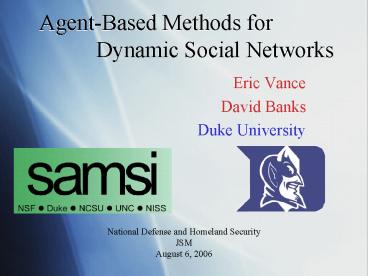AgentBased Methods for Dynamic Social Networks - PowerPoint PPT Presentation
1 / 40
Title:
AgentBased Methods for Dynamic Social Networks
Description:
Agent-Based Methods for Dynamic Social Networks. Eric Vance. David Banks. Duke University ... How to summarize a social network? Add rules to better reflect reality. ... – PowerPoint PPT presentation
Number of Views:50
Avg rating:3.0/5.0
Title: AgentBased Methods for Dynamic Social Networks
1
Agent-Based Methods for Dynamic Social
Networks
- Eric Vance
- David Banks
- Duke University
National Defense and Homeland Security JSM August
6, 2006
2
Social Networks
- Social Network analysis models relationships
between actors. - 1 signifies a friendship, 0 indicates the absence
of a friendship
FAB1 FAC1 FBA1 FBC0 FCA0 FCB1
B
A
C
3
Dynamic Social Networks
- How do networks change over time?
- Which features are stable, which are dynamic?
- How do we make predictions?
4
Agent-based models
- Program simple rules for agents in a computer
simulation. - Complex phenomena can be generated by individual
agents acting according to the simple rules. - Evaluate each new rule.
5
Static Social Network ModelHoff, Raftery, and
Handcock (2002)
- logit(pij)?0?s(sirj)? Xij-zi-zj
- Intercept ?0 is a baseline probability for
friendship - Sender si random effect
- Receiver rj random effect
- Vector of dyad-specific (observable) covariates
Xij - Positions (zi) in latent (unobservable) Social
Space - The distance between zi and zj in Social Space
affects the probability of a friendship from i ?
j. - Actors close together in social space are more
likely to be friends.
6
Our Approach--Motivation
- Students arrive at a boarding school having no
friends. - Each student occupies a position in Social Space.
- Students make friends at each time according to
simple rules which mimic the static social
network model.
7
Student Social Space
- Social Space is a useful proxy for that which we
cannot measure. - Students move towards their friends in Social
Space. - Students change their habits and interests to be
more similar to their friends.
8
Student Social Space
- Students close together have similar
characteristics
9
Simulation
10
Simulation
11
Graphs of Friendships
12
Graphs of Friendships
13
Graphs of Friendships
14
Graphs of Friendships
15
Graphs of Friendships
16
Graphs of Friendships
17
Graphs of Friendships
18
Graphs of Friendships
19
Graphs of Friendships
20
Graphs of Friendships
21
Graphs of Friendships
22
Graphs of Friendships
23
Graphs of Friendships
24
Graphs of Friendships
25
Graphs of Friendships
26
Graphs of Friendships
27
Graphs of Friendships
28
Graphs of Friendships
29
Graphs of Friendships
30
Graphs of Friendships
31
Graphs of Friendships
32
Graphs of Friendships
33
Graphs of Friendships
34
3 Rules for Agent Model
- 1. Students are endowed with a position (zi),
- SexiM or F, Charisma ci ? N(0,1).
- 2. Make friends according to probability pij
logit(pij)?0?s(cicj)? Xij-zi-zj - 3. Move 1/3 distance towards the average of
friends positions.
35
Agent Model Parameters
- Agents make friends according to probability pij
- logit(pij)?0?s(cicj)? Xij-zi-zj
- ? ?0 is baseline probability of friendship
- ? ?s is sensitivity of friendships to charisma
- ? ? is sensitivity of friendships to Same Sex
36
Evaluation Metrics
- 1. Number of Friendships (Dyad links)
- Completed Triads
- Triangles (incompleted triads)
- Number of singletons
- Distance moved in Social Space
- Number of Opposite Sex Friends
- Number of Clusters
- Shortest path length between nodes
37
Simulation Results
38
Simulation Results
39
Analysis of Results
- Approximate as a linear model
- Avg friends coef ?0 coef ?s coef ? ?
- The intercept ?0 has a very large effect. The ?
coefficient has a small effect.
40
Future Directions
- Use the model to estimate parameters for a
dynamic network with real data. - How to summarize a social network?
- Add rules to better reflect reality.































